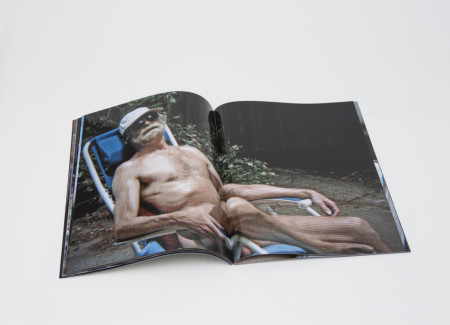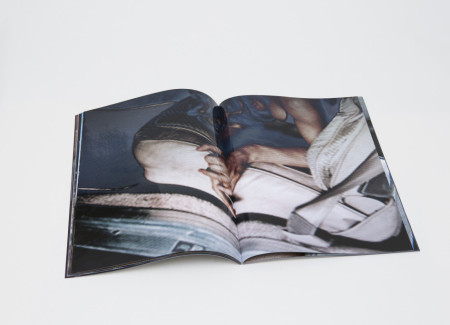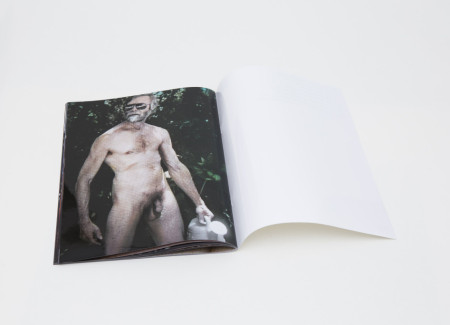JTF (just the facts): Published by Art Paper Editions in 2015 (here). Softcover, 48 pages (laminated), with 25 color photographs. In an edition of 500 copies. There are no texts or essays. (Cover and spread shots below.)
Comments/Context: Lotte Reimann is a German artist/photographer sharing her time between the Netherlands and her native Germany. Her online persona seems rather mysterious and elusive (with the main source of information being her website), but what we can tell with a degree of certainty is that Reimann is noticeably fascinated by cars. She is especially attracted by their metal carcasses, their steaming power, and of course, their distinguished smell (be it machine oil, glossy leather, or the scent of the road itself mixed with burnt tires). Her most recent photobook Jaunt interweaves her fascination with the car as a machine and as a venue for sexual fantasies. To quote Reimann (the text can be found on her website): “For me, personally, it’s not just the crash I relate to sexuality, but the car itself. Metal, steel, glass, leather, plastic, oil, and dirt – all agglomerated into one piece, which encloses me – blasting with tremendous speed through the landscape, is hugely exciting, arousing”. She takes us on a racy road trip, moving from J.G. Ballard’s erotic ideas in his fetishistic novel Crash (and its visual adaptation by David Cronenberg) to her own very personal and provocative interpretations.
The photobook offers no captions, no text, nor any other explanations of the narrative, but its brash story isn’t hard to understand. Jaunt is composed of a number of explicit erotic photographs mixed in with the shots of denatured landscapes and hot racing cars. All the images used in this project were found on the Internet – the basis for the narrative is a group of photographs taken by an anonymous middleaged couple (coded by Reimann as Mr. and Mrs. T.) who documented their sexual experiences and shared them online, where they were then discovered by the artist. Using this vernacular imagery as a starting point, she rewrote the story and stirred it up with other fictional elements and extra layers of her own devising. Rephotographing all of the images from her computer screen (sometimes as close-ups), she deliberately added a coating of perfect monitor grid lines; as a visual effect, it works as a continuous reminder of the strong presence of photographer’s own gaze and of her distanced appropriation of the narrative.
Reimann found her initial inspiration in J.G. Ballard’s Crash, carefully reworking its subject, aesthetic, narrative, and interpretations with the archive of Internet material. The central theme is clear – the hot fusion of the human body and parts of the machine produces anticipatory lust, building up into a sexually charged journey. The cover features a old white car, the viewing angle and the clouds of smoke leaving no doubt that it is ready to take off. The book opens with a tease: a young woman stands in a private room, posing for the camera, wearing nothing but black panties; a light reflection covers part of her face, making it hard to read her facial expression. The uncensored erotic images Reimann included in Jaunt set an alternately sinister and openly seductive mood. One of the following shots is an extreme close up of a female foot in a high heel as it is about to hit the acceleration pedal; it brings control, tension, and eroticism together in one simple image. Next, a bearded older man in a hat and sunglasses relaxes naked in a chair in his garden (maybe even close to the swimming pool); the roses are blossoming in the background. There is also a nude man cradled in the driver’s seat (the face is cropped out); his body covers most of the image but the details of a steering wheel and handbrake are also in the shot. Again and again, the human body and the machine are intermingled and unified. Riemann goes on to include images of blurry close-up of sexual intercourse, muscles, moments of pleasure, and various explosions, which are then mixed with the clouds of exhaust gas, tire imprints on the road, the violence of high speeds, and shots of the racing cars, producing a chain of free associations where human muscles and machine power work together. The visual narrative of the book turns this into a dynamic and often unabashedly explicit flow.
The book itself is printed on a regular paper and was laminated afterward; it is still relatively thin and has a slippery texture. All the images are full bleed and extremely glossy, resembling and echoing the voyeuristic shininess of the computer screen.
In the end, Reimann effectively repurposes and re-envisions these found images, creating a striking meta-narrative that works well in a book format – as a book, it’s fast, aggressive, and sexy. Conceptually, she’s taken archival exploration in a fresh direction, freely introducing the fictional and the personal. Using this imagery as the raw material for her own gaze, she’s pushed beyond the existing history of the pictures and let her own fantasies redirect and amplify the story.
Collector’s POV: Lotte Reimann does not appear to have gallery representation at this time. Collectors interested in following up should likely connect directly with the artist via her website (linked above).
















